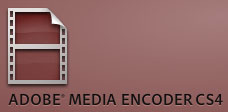Last fall, Adobe released Creative Suite 4. The CS4 upgrade featured a new Flash Video encoder. Encoding Flash video is a big deal cuz video-on-the-web is a big deal (and getting bigger every day), and cuz Flash video is the predominant web-video format .. with some sources claiming usage as high as 84%.

The new CS4 Flash Video encoder comes with the following products:
Up to CS3, this encoder was called the » Flash Video Encoder (FVE) .. or the Flash CS3 Video Encoder (FVE.CS3). [ *** See UPDATE note #1 at the end of today's entry. ]
With the release of CS4, Adobe change its name to » Adobe Media Encoder (AME) .. or Adobe Media Encoder CS4 (AME.CS4) .. cuz it does more than encode just FLash Video files (FLV).
If you search for the terms » Adobe Media Encoder CS4, you might wind up » HERE, a page which contains a 62-MB *upgrade* (v4.01) to the AME.CS4. But nowhere could I find a download for the AME.CS4 encoder itself (a stand-alone version).
You might also stumble across this page, titled » Flash Media Live Encoder 3 (FMLE.3), which offers a free download (~5MB). But the free FMLE.3 encoder is not the same product as the Adobe Media Encoder that ships with the CS4 versions of Flash & Premiere Pro.
Even more confusing .. you might stumble across links to something called the » "Adobe Flash Media Encoder" (FME - note no 'Live' here). But this is not the new AME.CS4 encoder either.
Actually, this is an older version of Flash Media Live Encoder 3 (FMLE.3). With version 3, Adobe added the word 'Live' to differentiate this product from the new AME.CS4 encoder.
••• today's entry continues here below •••
Long story short » you cannot download a stand-alone version of the new AME.CS4 encoder .. trial demo or otherwise .. at any price. No such animal exists. [ *** See UPDATE note #2 at the end of today's entry. ]
With that out of the way, let me take this one step further by saying that Flash video can be divided into two basic categories:
- LIVE video (» real-time capturing, encoding & delivery .. think of a sporting event being streamed live across the 'Net .. hence FMLE.3)
- Video ON DEMAND (» think of an event that occurred in the past .. e.g. your baby's first steps .. something you can sit down and edit before-hand .. hence AME.CS4)
Moreover, video ON DEMAND can be further divided into two distinct categories:
- PROGRESSIVE download (P-D)
- STREAMING video (S-V)
Most Internet video is delivered via P-D. Hobbyists like me would prefer the progressive-download format, since a Flash Media Streaming server can be pricey. (Or you could opt for a Flash Video Streaming Service.) Here's a decent discussion of » P-D vs S-V.
State-of-the-Art encoding for web-video is a BIG subject, including topics such as the new H.264 codec. The point I want to make however, is » if you want to use the new CS4-based Adobe Media Encoder to encode your video files (and who doesn't?), you'll need a copy of Flash Pro (or Premiere Pro or After Effects).
I was surprised to find this basic info so difficult to uncover. With multiple encoding products (that go by constantly evolving names), I would expect Adobe to post a matrix containing descriptions of the different products, along with their past & present name-ology, explaining designed usage, limitations, ways to appropriate, download links, upgrade links, etc. A basic primer that compares & contrasts the different products for those uninitiated with the world of Flash video. If such a matrix exists, I could not find it.
UPDATE: Two clarifications from Laurel »
- Adobe Media Encoder actually shipped with the CS3 production applications (Premiere, After Effects) so it's not an entirely new application - but greatly improved in CS4.
- It is available in the 30-day trials of the CS4 applications (Flash Pro, Premiere & After Effects) with a few limitations (certain codecs such as MPEG-2 are disabled, H.264 import isn't supported) but is not available stand-alone.
While chatting with Laurel on the topic of what I'd like to see from Adobe (in addition to the Matrix mentioned above), I also requested they release a free, stripped-down stand-alone version with limited functionality. (Can't hurt to ask, right?) And also a full-boat, fully-functional version (also stand-alone) .. for whatever price Adobe feels is reasonable & appropriate.
For more along these lines, here's a Google search preconfigured for the query » adobe media encoder cs4 flash video

H264 is the way to go. Though many prefer FCP simply beacuse media encoder sucks while rendering MPEG 2 streams. This is not the fault of the mainconcept encoders. Just that the GOP settings arent smartly tweaked.
Actually, there are two "Adobe Media Encoders". The new stand-alone one is basically just a replacement for Flash Media Encoder CS3, and that is the very limited/crappy one that this post is about and can only encode to MP4 and FLV. The old one is the much better one, and is built into Adobe Premiere Pro. It can encode to a variety of formats including the above plus about 20 other formats. It is the much more powerful encoder, and the new stand-alone update to the flash encoder is pretty lame. I cannot believe this post infers that it is powerful...it is not at all.
are you saying the encoder that comes with premiere is different from, and better than, the encoders that come with flash and after effects?